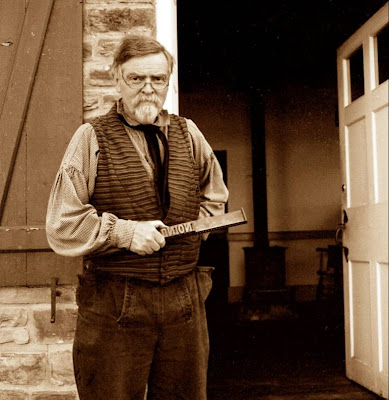 |
| Ted Shuart, Printer, The Farmers' Museum. June 2011. |
You could say that I was born into it. My whole family was in the antiques business, and I even slept in a rope trundle bed as a small child. When the centennial of the Civil War came around in the 1960s, it really stimulated my interest because I read everything I could about the units and the battles. Eventually I became involved in reenactments and helped to start a local group of reenactors who traveled to schools and historical societies to do presentations. My day job as a graphic artist at a local newspaper gave me some of the basic skills that I continue to practice here in the Printing Office. I came here as a Museum Teacher twelve years ago to get a foot in the door of the museum and eventually became the printer when that job opened up.
What did it take to learn the craft of Letterpress printing?
The first thing I did was review the notes and books of the museum printers who had worked here for more than sixty years; they are a treasure trove of information. After that I started working with other museum printers, including staff from the Shelburne Museum and the Smithsonian Museum of American History. They helped me understand the finer points of printing from typesetting through inking and on to printing pressure and press mechanics.
What is your favorite object in the Middlefield Printing Office?
It would probably be the Robert Hoe Washington Hand Press. It was made in 1828 and is one of the oldest presses of its kind in
What is your next big
project?
I’m presently setting up a children’s book based on
one printed by Elihu Phinney here in Cooperstown
in the nineteenth century. That edition
will run to 1,000 copies and will use the original illustrations. Also, since this is the Sesquicentennial of
the American Civil War, I am researching and reproducing recruitment posters
from the early years of the war.
Why do you think it is important for people to understand early printing techniques?
Letterpress printing is the basis of all of our
graphic arts today. Books, magazines and
newspapers all had their start in printing offices like this. Even the basic
terms of printing – like font, typestyle, upper and lower case – all refer to
letterpress techniques that have carried over to digital printing. Many of the
visitors who are most interested in the shop are modern designers and printers
who have become interested in letterpress printing not only because it is the
roots of the current industry, but also because the quality of work printed on
presses like these has yet to be duplicated digitally.
A Note about the Faces of The Farmers' Museum series: This series of blog posts combines staff portraits made in the style of nineteenth-century occupational photographs using film-based photography. The idea came for this when I found a box of long-expired film in a museum storage area. Using the film from the early 1990s, a fifty-year-old Rolleiflex camera and ancient photographic chemicals gave a reasonable facsimile of the images of farmers, tradesmen and community leaders that were popular 150 years ago.

No comments:
Post a Comment